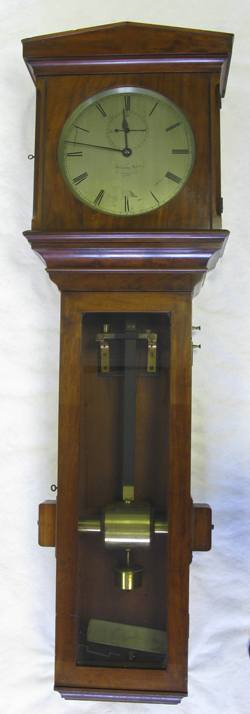Electric Pendulum Clock
British, after 1845
Manufactured by Alexander Bain
Metal, wood, glass
Presented to the University of Glasgow in 1936 by Glasgow City Councillor William Brownhill Smith, MVO, MBE
Restored in 2014 with the assistance of a grant from the Antiquarian Horology Society
GLAHM C.1936.1
On display in the Hunterian Museum (Science Balcony)
This is one of the world's first electric clocks, designed and built by Scottish inventor Alexander Bain. Its pendulum was driven by an 'earth battery' that consisted of two electrodes buried in the moist ground, and it could be connected electrically to other clocks, functioning as a central 'governor' transmitting time to geographically distant locations.
Between 1841 and 1852 Scottish-born Alexander Bain (1810-1877) took out a series of patents for electrically-driven pendulum clocks. Whilst the German C.A. Steinhiel developed similar systems independently in the late 1830s, and Bain himself was later engaged in disputes with prominent scientist Charles Wheatstone (1802-1875) as to who exactly had had the idea first, Bain is nevertheless usually and reasonably referred to as the 'father of electrical horology'. His clocks were electrically driven, and also capable of electrically controlling other geographically distant clocks. Bain realised the technical and bureaucratic possibilities of connecting clocks electrically: one central clock could drive many others, exactly synchronised, 'all the clocks in the kingdom connected by wires, so as to receive the time from one governing clock'.
Bain's original designs were powered by an 'earth battery' consisting of two electrodes, one made of zinc, the other made of copper or carbon, buried in the moist ground, creating a circuit and inducing a small but stable current to flow through a coil of wire within the pendulum bob. When put in motion by a small push, the pendulum, which by virtue of the electric current running through the coil became a temporary magnet, was attracted to one of two permanent bar magnets inside brass tubes fastened to the sides of the clock case. As the pendulum swung, a sliding switch higher up the pendulum rod passed over and beyond gold contact points, breaking the circuit. The pendulum thus swung back in the opposite direction by its own weight, only to complete the circuit again, resulting in the pendulum bob being attracted to the opposite permanent magnet, and so on. A variant design by Bain had the circuit running through coils in the side of the case, with the pendulum bob itself a permanent magnet. In traditional pendulum clocks the simple harmonic oscillation of the pendulum regulates the dissipation of energy provided by an external source, typically a weight suspended from a cord, which needs to be periodically wound up. In Bain's clocks, the pendulum both regulates the clockwork but also provides the source of power, an unusual and not always satisfactory arrangement.
A clock very similar to this one was in the possession of the University in the 1870s, and was probably used by William Thomson in the Natural Philosophy classroom. Bain himself fixed, adjusted and regulated that clock at least once, as can be seen in a receipt in the University Archives from March 1872 which records a payment of £1 and five shillings from Thomson to Bain for 'adjusting and regulating the Clock at the University' and providing 'one battery box and four new bits of gold for the break of Electric Clock [sic]'. Its current whereabouts, sadly, are unknown.
The Bain clock shown here was donated to the University in 1936. It is thought to have been made to work in 1941, the hundredth anniversary of Bain's first patent. In October 2014, following conservation, it was made to work briefly, powered by a simple AA battery.
Alexander Bain Pendulum Clock
Since the making of this film, The Hunterian received the sad news of the passing of Nick Sanders, Electrical Engineer and Electrical Horologist. We are lucky to have had his support and expertise in this project.

